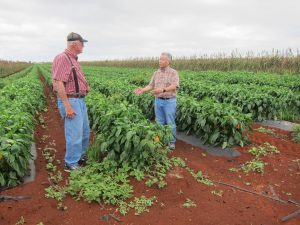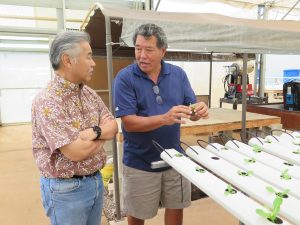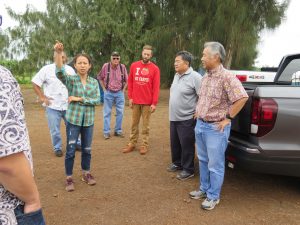Growing ag: Farming for the future in Central O’ahu
Posted on Sep 12, 2019 in Capitol Connection, FeaturedFor most of us, increasing local food production sounds like a great idea — especially because the state imports about 85 percent of the food we eat. But how do we grow food on a scale big enough to make a difference? On a recent visit to agriculture operations in Kunia and Mililani, Governor Ige heard from the people who are expanding crop potential every day in Central O‘ahu. They include farmers like Larry Jefts, Shin Ho and Fred Lau and leaders from the state Department of Agriculture (HDOA) and the Agribusiness Development Corporation (ADC).
Together, they want to help consumers see the local possibilities as part of a larger network — from traditional farming and high-tech greenhouses to a harvesting and distribution system and UH community college students trying new commercial food ventures as part of their training. “We need to dispel the myth that nothing is happening with farming in Central O‘ahu,” said Jefts, one of the state’s most successful commercial growers and among the largest producers of fresh produce. He showed the governor acres of fertile farmland already in production and described some of the challenges he and others face in bringing their fruits and vegetables to market.
Jefts was the first farmer to successfully grow watermelons and bell peppers on lands that had lain fallow when Del Monte stopped pineapple production. This year his Kelena Farms produced more than a million pounds of head cabbage, which is one-and-a half times larger than the average yield in California, according to HDOA. Jefts’ family-owned farm of 6,000 acres includes watermelons, bananas, bell peppers, tomatoes and cucumbers, as well as cabbage. His Sugarland Farms produces about 80 percent of the state’s tomatoes.
“Developing fallow ag lands into high-production farming operations is part of our strategy to increase our food security,” said the governor. “We want to support more Hawai‘i farmers and show that diversified agriculture can thrive on what used to be plantation lands.” HDOA director Phyllis Shimabukuro-Geiser said the department is in the process of filling two new positions for a farm-to-state initiative to bring Hawai‘i-grown food to island prisons and hospitals — an expansion of the popular farm-to-school, ‘Aina Pono program in several public schools. ADC is managing 1,200 acres from the former Galbraith Estate and has invested millions to prepare the land for diversified farming in what is being called the Whitmore Project. “ADC is developing water infrastructure because without water you can’t have farmers,” said executive director James Nakatani. ADC is also providing 24/7 security in an area designated for small farmers to protect equipment from theft. The land is sub-divided into lots of varying sizes — from five to 90 acres — each with its own reservoir for water and farms in various stages of development.
Shin Ho of Ho Farms leases 62 acres in the area. “We mainly grow cherry tomatoes, eggplant, okra and Japanese cucumbers,” she said. “We’re also planning to plant about 1,000 avocado trees.” Ho said her family has been farming since 1991, and she and her brother have been doing it full-time for about 13 years. She said she appreciates the 24-hour security because it allows her to focus on her farming. “We deal with break-ins every day at our other parcels so the arrangement here is a blessing.”
Jefts and his wife took their own leap of faith when they left the Midwest and moved to Hawai‘i in 1978. “We didn’t know anybody, but we started farming on Moloka‘i, thanks to a Hawaiian family who ‘adopted’ us. We were there for 10 years before coming to O‘ahu.” With his years of experience, Jefts helps other farmers and works with his son, Jonathan, to keep the business in the family. He maintains farming is a business, not a lifestyle. But to hear him and the others talk, it’s obvious that working the land is in their blood. Never mind the hard labor, finding good workers, fighting off bugs, maintaining a marketing, packaging and distribution system, and keeping thieves from stealing equipment — all while trying to make a profit.
So what does it take to be a farmer entrepreneur? “Pure, raw struggle to figure out the business side of things,” said Jefts. “Farmers need to understand the ramifications of their next purchase. You have to be a calculated risk-taker, but you also have to be a realist. And you have to love what you do.”


